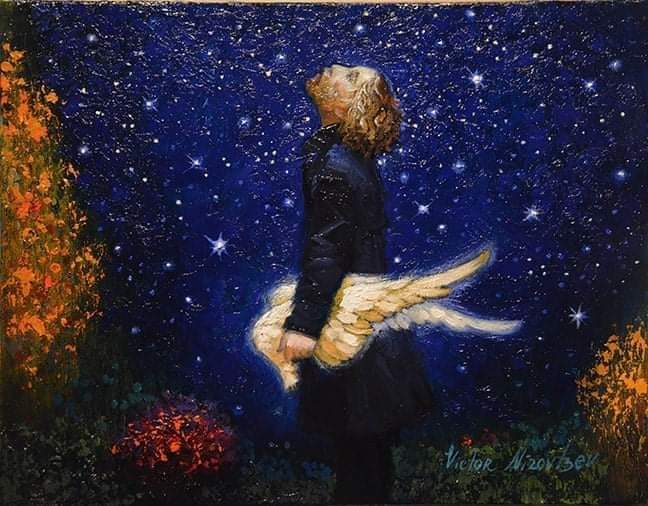Before wings, there was the whisper.
Before feathers brushed the ceiling of cathedrals, before halos caught candlelight in golden arcs, angels walked among us like strangers on a road. They came quietly in the stories of old—cloaked in the guise of dusty travelers, their feet planted firmly on the earth.
In the earliest pages of sacred memory—the Hebrew Bible—angels arrived without fanfare. Mal’akhim, messengers, word-carriers of the divine. They warned, they comforted, they wrestled with prophets beneath moonlit skies. But not one bore a wing. Not yet.
Abraham saw them at his tent, offering news of life from barren wombs. Jacob grappled with one until dawn cracked the horizon. But they looked like men. Strong, silent, ordinary. Heaven, it seemed, spoke through the familiar.
And yet, far older myths stirred in the soil beneath their feet.
Echoes from Ancient Skies
In the temples of Mesopotamia, stone guardians stood with eagle wings outstretched—lamassu, part lion, part god. In Egypt, Isis spread her mothering wings wide, wrapping the dead in comfort. The Greeks carved Nike, goddess of victory, aloft on swift feathers. Hermes raced across skies with wings at his heels.
To wear wings was to escape time. To transcend dust and blood and bone. To belong to the sky.
These were the images carried by empire—symbols in stone and story, waiting to be reborn in new faiths.
Christianity’s Early Silence
In the dark, cool catacombs of Rome, early Christians painted angels as the ancients had painted gods: serene young men in flowing robes. No wings. Just presence. Just purpose.
Theirs was a faith still hunted, still tender. They dared not borrow too much from the pagan world, lest their truth be mistaken for myth. So angels remained earthbound in those early frescoes—messengers who came not with thunder, but with footsteps.
But the empire changed. The church grew roots. And with acceptance came imagination.
The Gift of Wings
It was sometime in the 4th century, after Constantine’s conversion, after catacombs gave way to cathedrals, that the first angels unfurled their wings.
Look to the Catacomb of St. Priscilla—there, perhaps for the first time, an angel is seen taking flight. The wings are soft, tentative, like a hush before a hymn. But they mark a turning.
From then on, the wings spread wide across frescoes, icons, and illuminated pages. By the 5th century, the sky was full.
Artists reached back to Nike and forward to Gabriel. They gave wings to messengers and guardians, to cherubim and to the archangels who watched over battles and births alike.
And theologians—word-weavers of the sacred—began to offer reasons.
Feathers as Symbols
St. John Chrysostom said the wings were not of flesh but of speed and fire, signs that angels move by the will of God alone.
St. Gregory the Great saw wings as a metaphor for transcendence—for the ability to rise above the petty affairs of mortals.
But it was Pseudo-Dionysius the Areopagite, that mysterious mystic of the 6th century, who gave wings their hierarchy. In The Celestial Hierarchy, he painted heaven as a tiered choir: seraphim and cherubim closest to the throne, ablaze with wings and song. Archangels, dominions, virtues—all ranked in sacred order, all winged according to their nearness to divine fire.
The church would follow suit. Painters would take note. Feathers multiplied.
By the Middle Ages, every angel bore wings—soft, swanlike, or blazing like sunlight on water. They bent over altars. They crowned saints. They wept at crucifixions and rejoiced at dawns.
Theologians like Thomas Aquinas insisted that angels had no bodies, no need for wings. But the artists did not care. The people needed to see what their hearts already believed: that heaven draws near, that it touches earth lightly, like a feather landing on your shoulder when you're not looking.
Beyond the Cross and the Crescent
Elsewhere, in the great flowing script of the Quran, angels are also winged. "Some with two, some with three, some with four" (Surah Fatir, 35:1). Jibril (Gabriel), bearer of the sacred recitation, was said to have wings that filled the sky. In Islam, too, wings became the sign of a heavenly origin, a reminder that the divine can descend gently, like light through a window.
In Jewish mysticism, particularly the Book of Enoch, angels blaze with fire and bear wings—too many to count. The heavens teem with watchers, scribes, and beings too strange for names. The imagination of the mystic is unbound. The sky is crowded with mystery.
Wings in the Modern Mind
Today, we still draw them with wings.
In movies, they walk through cities with shadows of feathers trailing behind. In novels, they fall in love and fall from grace. In cemeteries, they kneel in stone beside names we once whispered.
And when we are frightened or grateful or alone, we speak of guardian angels. We picture them hovering—just barely out of sight, just barely out of reach.
Whether literal or symbolic, whether doctrine or dream, the winged angel endures.
It is the shape we give to hope with a spine. The form of faith that moves. A reminder that something watches, listens, carries.
That there is a wind beyond this world, and sometimes, it brushes past us on the wings of a messenger.
Suggested Readings for the Soulful and the Curious:
• Angels: A History by David Albert Jones
• The Celestial Hierarchy by Pseudo-Dionysius the Areopagite
• A History of Heaven by Jeffrey Burton Russell
• The Iconography of Angels by George Ferguson
• The Bible: Isaiah 6, Ezekiel 1, Genesis 18
• The Quran: Surah Fatir (35:1)
• The Book of Enoch (Apocryphal, but influential in Jewish and Christian mysticism)
|
|

